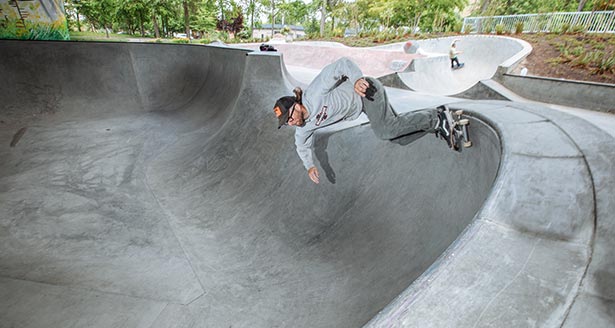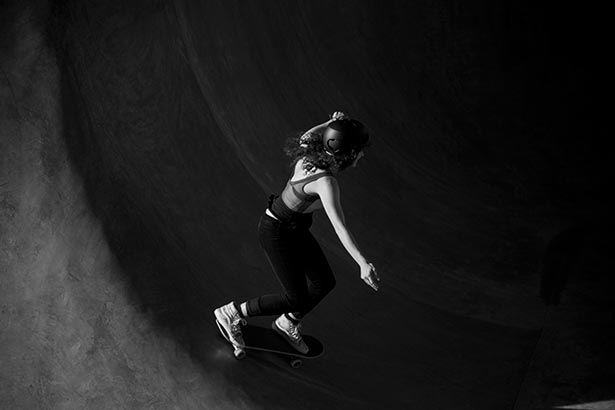
Close your eyes and listen: The continuous buzz and grind of trucks biting the paved surface sounds like some glorious machine of perpetual motion. Open your eyes, and you behold a swarm of human activity — zooming bodies crisscrossing in space, as one boarder goes airborne and another perches on the berm, greedy to drop into the bowl.
This is Eugene’s new WJ Skatepark + Urban Plaza, formerly the den of iniquity known as Washington Jefferson Park, where dirty hypos once hung thorny in the bushes. Like some concrete utopia risen from the dregs of urban squalor, the WJ Skatepark presents a stunning vision of realpolitik in action: The kids and the community asked for a sick place to skate, and the city and the neighborhood colluded, making it happen.
“It just has this energy down there that wasn’t there before,” says Colette Ramirez-Maddock, community events manager for the city of Eugene’s Library, Recreation and Cultural Services. Ramirez-Maddock has been instrumental in organizing the WJ’s grand opening on Saturday, June 21, which is also international Go Skateboarding Day. “It’s our first chance to show the community what the potential of this redesigned park is,” she says of the opening, which will feature a host of events including live music by local favorites Sol Seed and Lafa Taylor as well as Fresno’s Strange Vine, bike and skate lessons, basketball, horseshoes, bike polo, a helmet give-away and more.
 |
|
‘It’s definitely one of the best around. It’s got everything.’
Drayke Mohr, rides for Sasquatch Boards and Portland Wheel Co. Photo by: Trask Bedortha.
|
Tactics Boardshop, which has been involved with the construction of the skatepark from its inception, will host a competition during the grand opening, with many more events planned in the future. Jeremy Conant, Tactics marketing director, echoes the sentiments of many when he says the opening of WJ is a boon to the skating community as well as city in general. “The park is a game-changer for Eugene’s skateboarding scene,” Conant says. “Now, almost daily, we’re seeing high-caliber skaters swinging into town, checking out the new park and raving about it.”
Conant points to the broad and long-term benefits such a skating destination could have for the city. “We’re going to see a positive economic impact for businesses in the downtown and Whiteaker areas,” he says. “Already the park is proving to be a valuable catalyst for tourism in Lane County, not to mention the fundamental benefits of having an outdoor place where Eugene’s youth can play.”
And play they do. The sentiment at ground zero — where the boys and girls on boards show their stuff with endless ollies, carves, kickflips and crashes — is nearly universal: WJ is the shit. “I honestly think this park has every element,” says skater Burke Morris, who also works for Dreamland, the Lincoln City company that designed the park. “It’s all contextualized. You have a piece of everything for transition skating.”
Portland-based skater Andrew Pugh, co-owner of Sasquatch Skateboards, says WJ is one of the best parks Dreamland has built. “It’s definitely a good spot for Eugene,” Pugh adds. “They needed something like this. Give it some time; some crazy kids are gonna be coming up. It’s definitely unique. It’s more than just a park. It’s almost artistic, too.”
 |
|
‘it’s exceeding our expectations. it put eugene on the skate map, for sure.
it’s going to bring people in from all over.’
Dreamland Skateparks designer Burke morris
|
Noah Dailey-McIlrath, who grew up skating the streets of Eugene, says the new skatepark — and the skaters that use it — has altered the landscape of this once down-and-out wasteland under the overpass. “There’s always activity down here,” he says, adding that most of the unsavory activity has been quashed. “People that use the park don’t want that kind of shit. Skaters are a demographic that’s comfortable with self-policing. It seems to have cleaned it up a lot.”
Conant from Tactics says that, save for “minor” issues here and there, like parking and loitering, the response to the park has been overwhelmingly positive. “When you spend time at the park almost daily, what you see is a lot of youth having a great time, respecting one another, challenging themselves and encouraging each other,” he says.
Ramirez-Maddock from the city says the all-day grand opening Saturday, with events scheduled from 10 am to 8 pm, should give the community at large a change to witness first-hand the various benefits of such a site, as well as evidence of a city and its residents coming together for the common good. “It’s challenged our city departments to work more collaboratively than I’ve ever seen, which is exciting,” she says of the creation of WJ Skatepark. “This is, I think, how things might happen in the future. That’s one of the coolest things.”
The Grand Opening Celebration for WJ Skatepark takes
10 am-8 pm Saturday, June 21, between Jefferson St. and 1st Ave. beneath I-105 bridge; bikers and skaters with decks can ride LTD free to the event; for more info and a full schedule, visit wjskatepark.org.
 |
|
‘There’s always activity down here. I’ve only seen it totally empty once.’
Noah Dailey-McIlrath. Photo by: Todd Cooper.
|
And play they do. The sentiment at ground zero — where the boys and girls on boards show their stuff with endless ollies, carves, kickflips and crashes — is nearly universal: WJ is the shit. “I honestly think this park has every element,” says skater Burke Morris, who works for Dreamland, the Lincoln City company that designed the park. “It’s all contextualized. You have a piece of everything for transition skating.”
Portland-based skater Andrew Pugh, co-owner of Sasquatch Skateboards, says WJ is one of the best parks Dreamland has built. “It’s definitely a good spot for Eugene,” Pugh adds. “They needed something like this. Give it some time; some crazy kids are gonna be coming up. It’s definitely unique. It’s more than just a park. It’s almost artistic, too.”
Noah Dailey-McIlrath, who grew up skating the streets of Eugene, says the new skatepark — and the skaters that use it — has altered the landscape of this formerly down-and-out wasteland under the overpass where Occupy Eugene once camped. “There’s always activity down here,” he says, adding that most of the unsavory activity has been quashed. “People that use the park don’t want that kind of shit. Skaters are a demographic that’s comfortable with self-policing. It seems to have cleaned it up a lot.”
Conant from Tactics says that, save for “minor” issues here and there like parking and loitering, the response to the park has been overwhelmingly positive. “When you spend time at the park almost daily, what you see is a lot of youth having a great time, respecting one another, challenging themselves and encouraging each other,” he says.
Ramirez-Maddock from the city says the all-day grand opening Saturday, with events scheduled from 10 am to 8 pm, should give the community at large a change to witness first-hand the various benefits of such a site, as well as evidence of a city and its residents coming together for the common good. “It’s challenged our city departments to work more collaboratively than I’ve ever seen, which is exciting,” she says of the creation of WJ Skatepark. “This is, I think, how things might happen in the future. That’s one of the coolest things.” ν
The Grand Opening Celebration for WJ Skatepark + Urban Plaza takes place 10 am-8 pm Saturday, June 21, between Jefferson St. and 1st Ave. beneath I-105 bridge; bikers and skaters with decks can ride LTD free to the event; for more info and a full schedule, see wjskatepark.org.
 |
|
‘We really wanted to bring a pro-social movement into the park
with the idea that we significantly increased safety at the same time.
’Emily Proudfoot, landscape architect City of Eugene Public Works
|
Design in Mind
New skatepark reflects years of work
The new WJ Skatepark + Urban Plaza — with its claim to fame as the largest covered, lighted public skatepark in the country — has attracted hundreds of visitors since the gates quietly opened April 4, but with a grand opening set for Saturday, June 21, this Eugene landmark is about to get its big reveal.
Originally suggested in the 1990s as an alternative to the wayward culture that existed under the bridge at Washington Jefferson Park, the skatepark project didn’t gain momentum until 2005, when more than 1,700 people signed a petition urging the city to act.
In 2008, Eugene’s Parks and Open Spaces Planning Office hosted numerous open forums to determine where the skatepark would be built. The following year, the city hired Lincoln City’s Dreamland Skateparks as the project’s primary designer. Dreamland sent design proposals back and forth with the city of Eugene, which hosted a series of five public workshops to determine the desired look of the park.
When the economy crashed in 2010, financial concerns put the project on hold. But private partners in the community, including Tactics Boardshop and various other local businesses, helped raise funds to meet a quarter of the park’s costs. With the Eugene City Council’s help, WJ Skatepark received a state parks grant as well as a district grant.
“We really wanted to bring a pro-social movement into the park with the idea that we significantly increased safety at the same time,” says Emily Proudfoot, a landscape architect for the City of Eugene Public Works.
By 2012, WJ Skatepark was back as a top-priority project for the city thanks to the public campaign. Proudfoot, lead architect on the project, estimates that renovations (including new restrooms, free wi-fi, energy-efficient lighting and a covered location allowing for year-round skating) on the 23,000-square-foot skatepark cost approximately $2.5 million.
 |
| Photo by: Sam Gehrke / olgehrkebastard.tumblr.com |
WJ Skatepark borrows features from legendary skateparks across the country, including a deep “kidney bowl” that replicates swimming pools skated in by the kids in the movie Dogtown and Z-Boys on the north end of the park, and a “snake run” on the east side. The golden concrete “ribbon” in front of the plaza is considered the iconic piece because, as a skate feature, it’s never been done before. When the right skater attacks the ribbon, Proudfoot says, it’s brilliant to watch. The red brick bank was inspired by the popular “China Banks” in San Francisco’s Chinatown.
The skatepark also boasts a public plaza, where people can sit and watch the skaters, as well as basketball courts, horseshoe pits and a new bike polo site. Many are actually using the plaza to skate as well. According to Proudfoot, some people call this the absolute coolest aspect of the park.
“It’s really kicked some life from a parks perspective back into Whiteaker,” Proudfoot says. “A lot of people have given us feedback saying that they’ve really enjoyed what we’ve done.”
 |
| Photo by: Sam Gehrke / olgehrkebastard.tumblr.com |